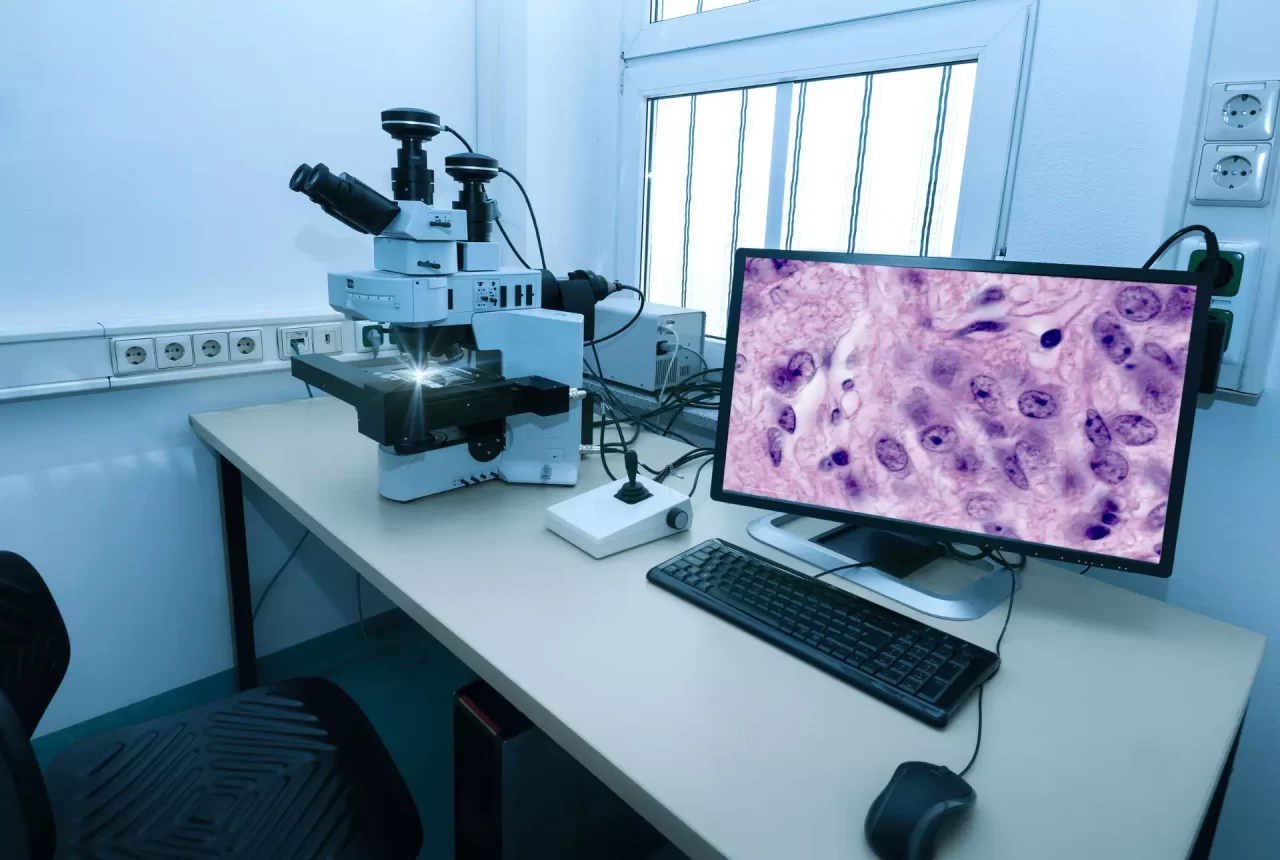Basically the goal of using computer vision in healthcare is to improve the quality of the care while reducing its cost. Additionally, this technology can increase the number of patients that healthcare institutions are able to serve. In the realm of healthcare and medicine, computer vision has the potential to revolutionize every aspect, ranging from the discovery and research & development of new medications, to patient delivery and all the processes in between that can be enhanced and optimized. In this article, we will mention some of the use cases and applications of computer vision in healthcare.
Computer vision can significantly expedite the process of research and development in healthcare. By analyzing the vast amounts of data generated during clinical trials, computer vision algorithms can identify patterns and potential correlations that could lead to the development of medical innovations.
1.Cell counting
Computer vision has proven to be a valuable tool in various applications, including medical research tasks such as cell counting. One specific use case involves the identification and analysis of neutrophils, a type of white blood cell, which plays a crucial role in understanding immune responses.
Traditionally, counting hundreds of neutrophils has been a time-consuming and labor-intensive process, causing delays in research progress and taking up to 40 to 60 hours to complete trial runs. However, by developing a model that recognizes the appearance of neutrophils using computer vision, the process can be significantly accelerated – taking less than 30 seconds to run an experiment.
With the neutrophils visualized and the model counting them, researchers are able to determine which part of the cell reacts to a specific medicine, drug, or compound. This advancement streamlines not only research and development but also the production process of these drugs further down the supply chain, ultimately benefiting the healthcare industry as a whole.

2.Assessing the physical function of a patient
Assessing physical function is important for healthcare providers because it provides crucial information about a patient’s physical abilities, limitations and for early diagnosis for some diseases. Aging or certain diseases may lead to a decline in physical function and it can be evaluated by a test called The Chair-Stand Test (CST). The CST has been shown to be a reliable and valid measure of physical function in older adults, as well as a predictor of various health outcomes -such as Sarcopenia-, and the risk of falls, hospitalization, and overall mortality.
Clinicians typically administer the test by asking the patient to perform the sit-tost and movement five times while using a stopwatch to measure the time. While this provides a rough idea of the patient’s condition, a more detailed analysis of the kinematic parameters of the movements provides deeper insights into their physical condition during the test. However, such analysis typically requires a sophisticated movement analysis laboratory.
Computer vision could be a good solution to provide clinicians with a cost-effective solution for capturing and analyzing the kinematic parameters of the movements as well as the time spent during the CST without the need for expensive laboratory equipment.
3.Diagnosis improvement
A major advantage of computer vision is its role in helping to detect and diagnose different illnesses at an early stage. By examining medical pictures like X-rays, MRIs, and CT scans, computer vision methods can spot patterns and irregularities that could be missed by the human eye. This results in quicker diagnoses and enables better planning for treatment, ultimately leading to improved health results for patients.
Pandemic
Computer vision technology has the potential to reduce the need for tests for some illnesses. By analyzing medical images with speed and accuracy, computer vision can recognize patterns and help doctors diagnose diseases better, acting as an additional pair of eyes to complement a doctor’s efforts.
For example, during the early stages of the COVID-19 pandemic, there was a significant shortage of tests, which greatly impacted the medical community. At that time, an open dataset became available, with numerous users working to identify the presence of COVID-19 in chest scans, comparing it to pneumonia, Middle East respiratory syndrome, and healthy chests.
The limited testing infrastructure at the start of the pandemic led to a need for efficient triaging and test allocation for the most vulnerable populations. By conducting an initial chest scan without using a specific COVID-19 test, medical professionals could determine if a patient had pneumonia or any signs resembling Middle East respiratory syndrome. If the scan came up clean, the test could then be allocated to someone with greater uncertainty, ensuring that resources were being used effectively during a critical period.
Cancer
In the field of oncology, for example, computer vision has been used to accurately identify cancerous skin lesions, sometimes outperforming experienced dermatologists. This early detection can lead to more effective treatments and a higher chance of recovery for patients.
In the field of dermatology, machine learning models have shown significant promise in improving diagnostic accuracy. In 2017, a machine learning researcher at Google, with no prior healthcare expertise, developed an application that could identify if a skin lesion was cancerous with greater accuracy than the world’s leading dermatologists. This breakthrough highlights the potential for machine learning models and artificial intelligence to revolutionize healthcare, enabling faster and more accurate diagnoses and treatments.
4.Drug discovery and development
Drug discovery is costly and time-consuming. Computer vision has been increasingly used in drug development to analyze and process large amounts of data in order to identify potential drug candidates and improve drug discovery processes.
For example, computer vision technology has been used to analyze high-resolution images of cells and identify cellular phenotypes associated with specific diseases, which can aid in the identification of potential drug targets.
Additionally, computer vision has been used to improve the analysis of drug efficacy data by automatically detecting and quantifying features such as cell morphology and protein expression.
Some companies are also using computer vision for drug discovery by training algorithms to recognize specific molecular structures and predict their properties, which can aid in the development of new drugs.
5.Optimizing Hospital Operations
Computer vision can also be applied to streamline hospital operations and improve patient flow. By using algorithms that analyze data from security cameras and other sources, hospitals can optimize patient scheduling, bed allocation, and even the movement of medical equipment. This ensures that resources are being used efficiently, ultimately reducing the cost of care.
Furthermore, computer vision can help monitor patients remotely, allowing healthcare providers to deliver timely interventions and reduce the need for hospital visits. This is particularly beneficial for patients with chronic conditions, who often require long-term monitoring and care.
6.Fall detection
Another computer vision application is used for “Fall detection”. These applications are used primarily to detect falls in elderly or at-risk individuals who may require immediate medical attention. These applications can be used in various settings including hospitals, nursing homes, and other care facilities, as well as in personal homes.

The Future of Computer Vision in Healthcare
As computer vision technology continues to advance, its applications in healthcare will expand beyond diagnostics and treatment. In the coming years, we can anticipate the emergence of more sophisticated algorithms capable of predicting illness before symptoms even manifest, as well as the development of personalized medicine tailored to patients’ unique needs.
Moreover, the integration of computer vision with other technologies, such as augmented reality and robotics, will open up new possibilities for medical training, remote consultations, and even minimally invasive surgeries.
Conclusion
Computer vision in healthcare has great potential and it can change every aspect of the industry. As computer vision technology evolves, it can play a major role in improving the quality of care, lowering expenses, and increasing the number of patients that healthcare institutions can attend to. By adopting computer vision, the medical community can not only transform patient care but also pave the way for a more efficient and effective healthcare system.

